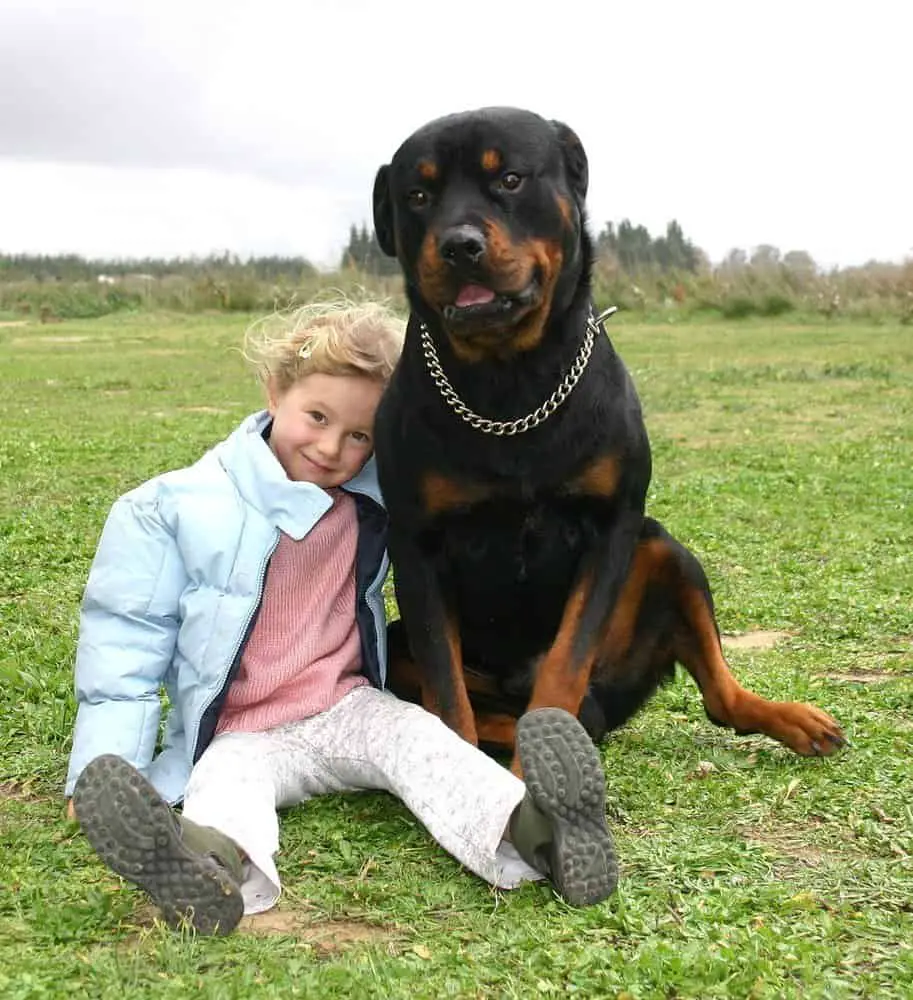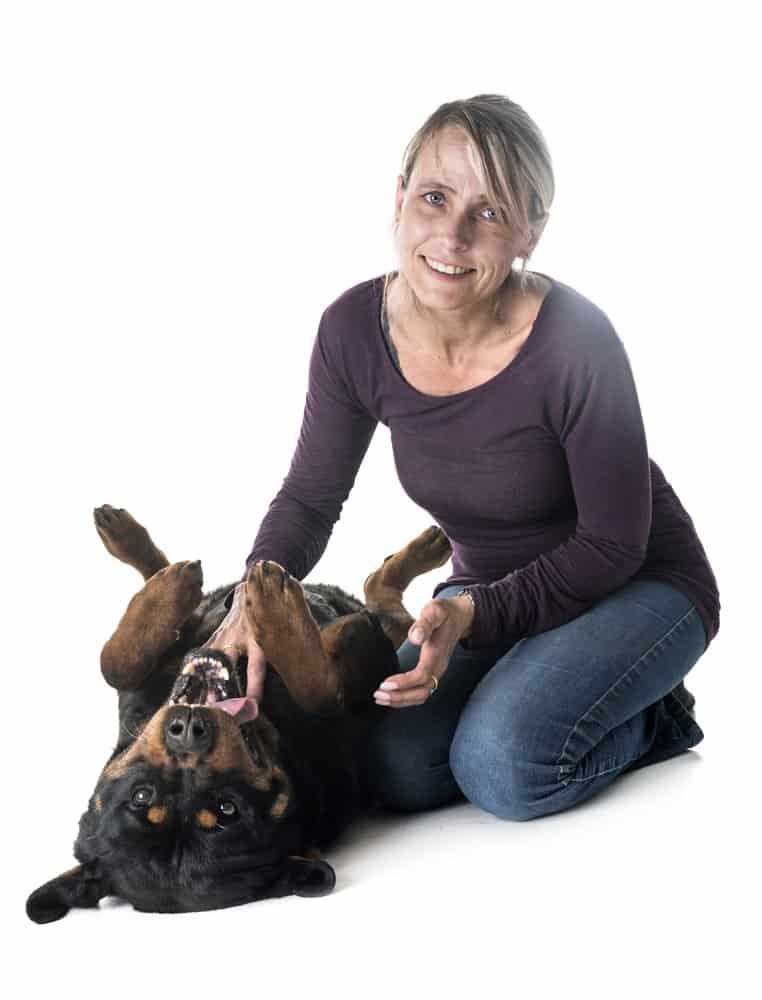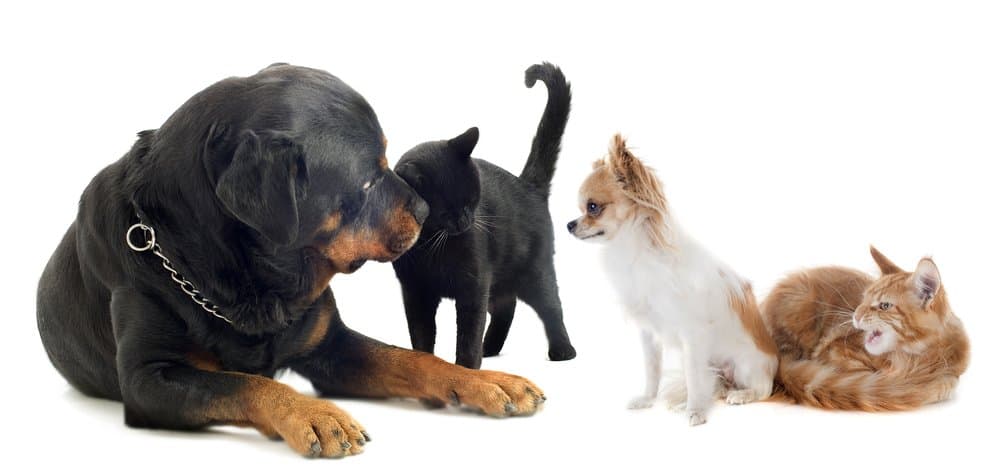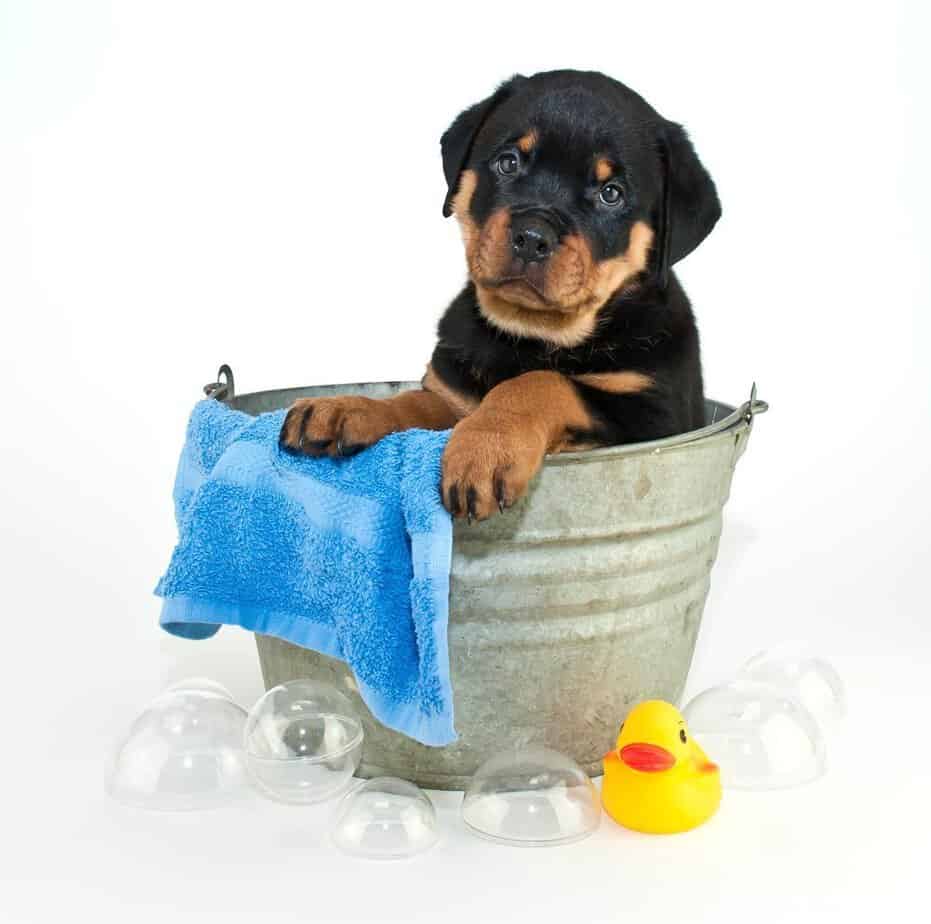Rottweilers are a famous breed of dog, often for the wrong reasons.
While many view the Rottweiler as a dangerous and aggressive dog, this is often just because they’re naturally protective and have long served in guarding and protection roles.
Other Names: Rottie, Rott
Country Of Origin: Germany
Dog Group: Working
Size: Medium to large
Recommended For: Families, couples, single owners
Maintenance Level: Moderate
Lifespan: 8-10 years
Temperament: Protective, loyal, affectionate
FAQ:
Good For the First-Time Owner: No
Good With Children: Yes
Good With Other Animals: Sometimes
Good With Strangers: Sometimes
Good For Apartments: No
Exercise Requirements: Daily walking
Can Live In Hot Weather: Yes
Can Live In Cold Weather: Yes
Can Tolerate Being Left Alone: Yes
Grooming: Moderate
Trainability: Moderate
Breed Overview:

Rottweilers were mainly used in Germany as livestock herding dogs and for pulling carts, which has resulted in an incredibly strong and intelligent dog with plenty of stamina.
With the right upbringing and training, Rottweilers make an excellent family pet and can be great around children.
Color: Black and tan
Height: Males – 24-27 inches, Females – 22-25 inches
Weight: Males – 110-130lbs, Females – 77-105lbs
Personality and Temperament:

The standard Rottweiler temperament is loyal and affectionate towards their owners, but also very protective of their property.
The breed’s use as a herding animal means they’re pretty intelligent and enjoy being given tasks.
This also means they usually excel in obedience competitions. However, the key to a happy Rottweiler is the right kind of training.
Rottweilers should be appropriately trained from a young age, so they know how to behave around other dogs.
The breed has a reputation for being aggressive, but this is easy to manage with obedience training.
Good Question: Are Rottweilers Dangerous?
However, the Rottweiler’s intelligence also means they can become stubborn. Because of this, owners need to be confident enough to control this, mainly as the breed is so physically strong.
When it comes to strangers, Rottweilers are known for being wary. This is why they make such magnificent protection animals, although this behavior can quite easily be taken the wrong way.
If you want a protection dog, then a Rottweiler is a great choice. If this isn’t specifically what you’re looking for then make sure you do everything possible to train any aggressive nature out of them.
Check Out China’s Protective Dog: Chinese Red Dog
However, when appropriately trained, a Rottweiler makes a great family pet. They’re very loyal towards their owners and form strong bonds with every member of the family, particularly children.
They love to play but are also very fond of a cuddle, which is another reason why they’re perfectly suited to family life.
Even though their reputation says otherwise, Rottweilers generally are not dangerous to have around other animals.

It’s important to introduce them as early as possible, and owners should still be wary around small pets.
The only time a Rottweiler can be considered dangerous is around another dog of the same sex, although this is much less of a problem if the Rottweiler has been neutered.
Rottweilers aren’t known as being an energetic breed, but their size means they still need plenty of exercises.
At least an hour’s daily walking should be the minimum, and this should be combined with plenty of playtime for mental stimulation.
Rottweilers are perfectly happy to laze around all day, but should still be walked enough to avoid obesity, which can be quite common in the breed.
Their size means that Rottweilers definitely aren’t suitable for apartment living. However, as this is mainly a space thing and not related to exercise needs, there should be a little problem where your property is, providing it’s large enough.
Most apartments won’t have enough space to accommodate a Rottweiler, and so houses are preferable.
Similarly, Rottweilers aren’t really a good choice for first-time owners. This is mainly because of how vital the right upbringing is, and while Rottweilers can be easy to train, the owner needs to be confident enough in their ability.
When it comes to such a strong dog as a Rottweiler, it’s understandable that most inexperienced owners would feel intimidated when faced with a Rottie that doesn’t want to behave.
Rottweilers are usually fine to be left alone, which is mainly from their role as a protection dog.
Unlike some other breeds, Rotties are happy to be left alone without company, but make sure you give them plenty of affection when you get home. This independent nature makes them a good choice for working owners.
Due to being bred in Germany, Rottweilers are much happier in colder climates than hotter ones.
Similarly, their coat is mainly black, which is excellent at absorbing heat. They were also bred selectively to keep warm, meaning they’re much better suited to the cold.
That said, you can keep them in hotter places, but just be careful about when you walk them, and for how long.
Grooming:

Rottweilers are easily recognizable by their coat colors, which are black with tan markings. Their coat is medium-length, quite coarse, and lies flat against the dog’s body.
Rottweilers shed throughout the year, but also have two main shedding seasons.
Grooming should consist of weekly brushing, but this should be increased to daily during shedding season.
Rottweilers benefit from being bathed reasonably regularly to keep their coat clean and healthy. However, this should always be done with a good quality moisturizing shampoo.
When it comes to nail trimming, this will need to be done more often than other breeds because Rotties have incredibly strong nails that don’t wear down as easily.
Owners might find it helpful to use a grinding tool instead of trimmers, and this will often be more comfortable for the dog too.
Rottweilers have floppy ears that need to be checked every few days for debris. Ears should be cleaned every week or two with some damp cotton wool.
As with all breeds, a Rottweiler’s teeth should be brushed several times a week to avoid tooth decay.
Common Diseases and Conditions:
The most common hereditary condition found in Rottweilers is hip dysplasia. This is because of the breed’s size and fast growth rate, although breeders are expected to have their stock x-rayed before breeding.
Neoplasia is identified as a common cause of death.[1]
Similarly, Rottweilers are also affected by a condition called osteochondritis dissecans, which is a very similar condition that impacts the shoulder joints. As with hip dysplasia, breeders test for this to minimize the risk of passing it on.
As previously mentioned, Rottweilers are also very prone to obesity, and the resulting health complications are the biggest cause of death in the breed.
To combat this, Rottweilers are often fed a specialist diet that’s high in protein and low in carbohydrates, along with being appropriately exercised.
History:

The Rottweiler has one of the oldest histories of any breed. They’ve been used as herding dogs for hundreds of years across Germany. Some believe they can trace the breed’s lineage all the way back to Roman drover animals.
It’s thought that some of these drover dogs got left in Germany, where they soon became a popular choice among livestock herders.
The breed is named after the city of Rottweil, which is in the Black Forest in Germany.
They were named after the city because it was an important trading hub during the Middle Ages. Butchers often used the dogs as protection dogs while they were out selling their stock.
However, as rail infrastructure improved, the need for Rottweilers died away. It got to the point that in 1882, the once-popular show breed was represented by a single poor example, where before there had been many Rottweilers in shows.
Rottweilers increased in popularity again during WW1 and WW2 as the need for police and service dogs increased.
You can read the Most Common German Dog Commands in our article.
Rottweilers were a great choice because of their natural strength, and the fact that it was easy to harness any latent aggression. This is where much of the breed’s bad reputation comes from.
Rottweilers began to find their way across the world during the late 19th and early 20th century. They were recognized by the American Kennel Club in 1931 and were first shown at Crufts in 1936.
The breed soared in popularity throughout the latter half of the 20th century and was, in fact, the most registered breed with the AKC in the 1990s.
Rottweiler Facts & Figures
Did You Know?
- If you’re looking to adopt a Rottweiler, expect to pay a reasonable amount. They can cost up to 1,500 USD.
- Rottweilers are well known for their instinct for guarding. While they’re not of the heaviest dogs, they’re easily one of the densest, and have an incredible muscle mass.
- While Rottweilers are seen as a dangerous breed, they’re actually very friendly and love human attention.
- The Rottweiler is still one of the top 10 most popular dogs registered with the AKC every year.
- The breed’s original name was “Rottweiler Metzgerhund”, which literally translates as “Rottweil Butcher’s Dog”.
- Rottweilers were one of the most popular search-and-rescue dogs used after the 9/11 attacks.
- Another major contributor to the breed’s reputation was the film The Omen. This reached fever pitch when scared viewers began to assume the breed was associated with the antichrist.
- Rottweilers are one of the “dogs with abs.”
You’ll find more German Dog Breeds in the links below:
References:
- [^] O’Neill, Dan G, et al. “Rottweilers under Primary Veterinary Care in the UK: Demography, Mortality and Disorders.” Canine Genetics and Epidemiology, BioMed Central, 22 Nov. 2017, https://www.ncbi.nlm.nih.gov/pmc/articles/PMC5698930/.

